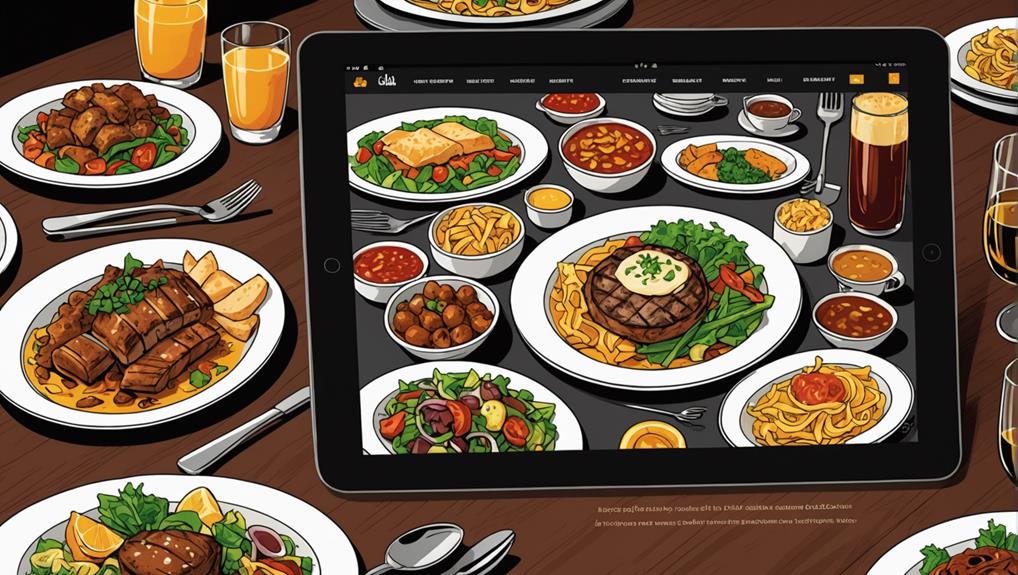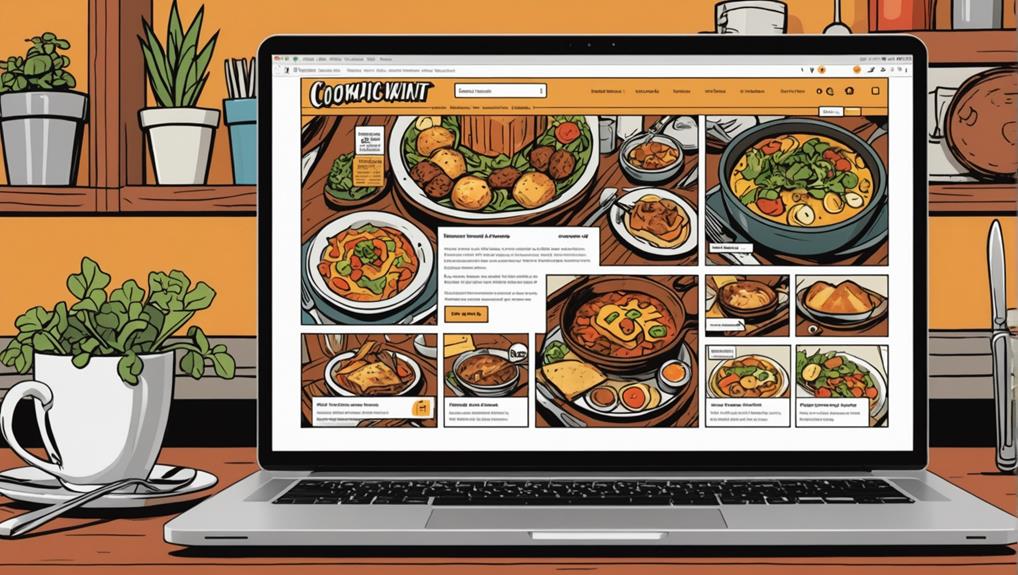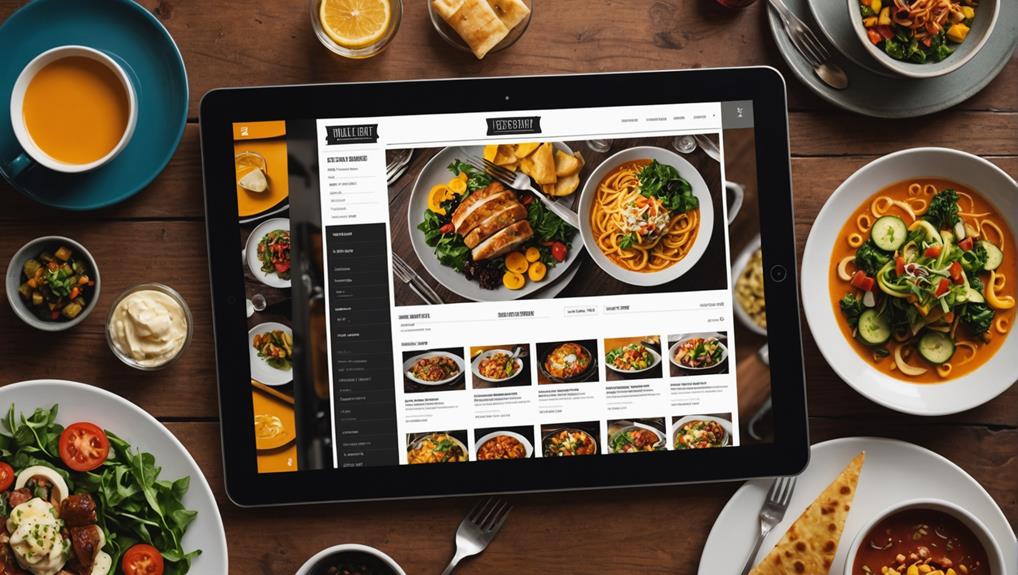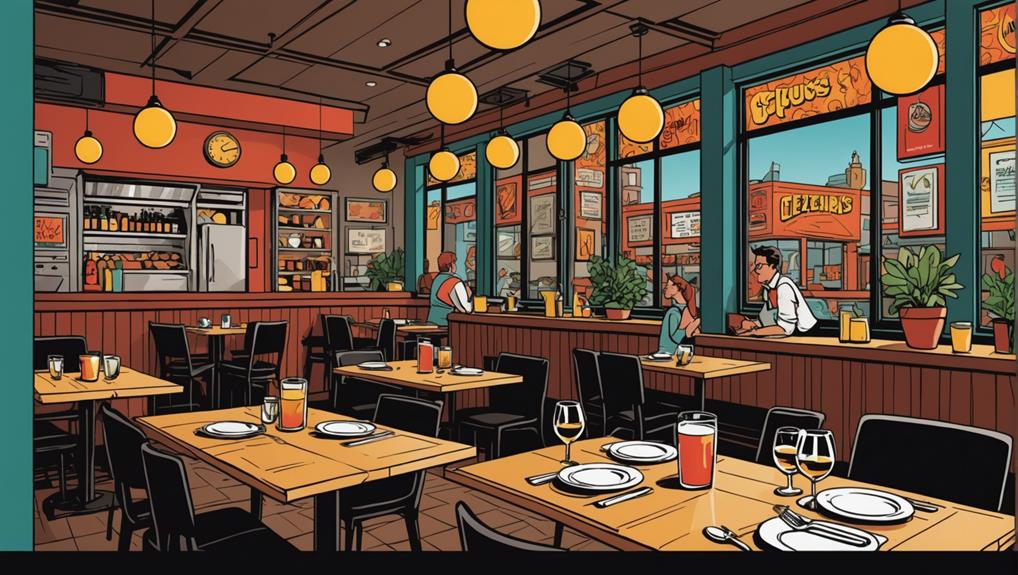
When you design a restaurant website, it's crucial to create an inviting online space. Around 77% of diners check your website before deciding where to eat, so clear menus, hours, and contact info are essential. Incorporating features like online ordering and real-time menu updates keeps things fresh and engaging. You should also focus on high-quality images that showcase your dishes and dining atmosphere. Remember, a smooth and mobile-friendly experience can boost customer loyalty. Embracing these elements can truly enhance how diners connect with your restaurant online. There's so much more to uncover as you build your digital presence.
Key Takeaways
- A well-designed restaurant website significantly influences diner choices and enhances overall dining experiences with essential information and features.
- Mobile-responsive designs cater to nearly 60% of users, ensuring accessibility and convenience for on-the-go diners.
- High-quality visuals, including authentic food photography, create an enticing online presence and foster customer trust.
- Integrating online ordering and reservation features streamlines the dining process and improves customer satisfaction.
- Effective SEO strategies, including keyword optimization and fresh content, enhance visibility and attract more potential customers.
Importance of a Restaurant Website

In today's digital age, your restaurant's website is more than just an online presence; it's an essential tool that can influence dining choices. Did you know that 77% of diners check a restaurant's website before deciding where to eat? A well-designed site can make a huge difference, while a poor one might turn away potential customers. You want to showcase your restaurant's unique theme and ambiance through modern design and intuitive navigation, similar to the custom brand building services offered by iindigo.
Make sure your website includes essential information, like a clear menu, hours of operation, and accurate contact information. This helps diners make informed decisions, boosting their satisfaction. Plus, incorporating online ordering and reservation capabilities enhances user experience, adding convenience and engagement. Imagine a potential customer browsing your site, easily finding what they need, and feeling excited to try your food!
Look at successful restaurant website examples to see how they attract customers. With a focus on online shopping features and a user-friendly layout, you can turn visitors into loyal patrons. Remember, a great website not only reflects your brand but also opens doors to new dining experiences. So, invest time in your site—it's worth it
Key Features for Success
To guarantee your restaurant's website stands out, incorporating key features is vital for success. A streamlined online menu that updates in real-time, perhaps through Google Sheets, keeps customers engaged and ensures they see the latest offerings. No one likes to arrive at a restaurant only to find their favorite dish isn't available!
Having a mobile-responsive design is essential too. With nearly 60% of internet users browsing on mobile devices, you want your website to look great and work smoothly on any screen. Plus, a user-friendly setup means you don't need coding experience to manage your content. You can keep your website fresh without a hassle!
Don't forget about being SEO-friendly. Optimized content boosts your visibility in search results, helping more people discover your restaurant online. Finally, using high-quality visuals, like mouth-watering food photography, makes your dining experience shine. Engaging images can entice potential customers and accurately represent what you offer. By focusing on these key features, you can enhance the customer experience and make your restaurant website a success.
Building Your Restaurant Website

Creating a restaurant website is like crafting a delicious dish; it requires the right ingredients and careful execution. Start by choosing a customizable template that reflects your brand identity. This unique design will help your restaurant stand out online. Make certain your website is easy to navigate, so customers can quickly find what they need.
It's essential to include important information like your location, contact details, and hours of operation. This way, potential diners can easily access what they're looking for. Don't forget to showcase your menu items! Using Google Sheets to update your menu and images in real time keeps your offerings fresh and engaging.
If you offer online orders, integrate essential payment methods and features like promo codes. This can streamline the ordering process, making it smooth for both dine-in and take-out customers. Test your website functionality by placing sample orders to ascertain everything works seamlessly.
Current Design Trends
Today's restaurant websites are all about simplicity, making it easy for you to find what you need. With minimalist designs, interactive menus, and stunning visuals, these trends not only look great but also keep your experience enjoyable. As you explore the latest styles, you'll see how these elements can really bring a restaurant's personality to life!
Minimalist Aesthetic Appeal
Simplicity in design not only enhances visual appeal but also transforms the user experience, especially for restaurant websites. A minimalist design focuses on essential information, guiding visitors without overwhelming them. By reducing distractions, you can let high-quality visuals shine. Imagine your mouth-watering dishes displayed prominently, capturing attention right away. Research shows that 94% of first impressions are design-related, so making a strong visual impact is vital.
With intuitive navigation, visitors can find what they need—like menus and contact details—quickly. This is important because 44% of consumers leave a website when they can't find specific information. Plus, minimalist designs often load faster, which boosts user experience. After all, slow websites can hurt your search rankings, making it harder for hungry customers to find you!
A cohesive color palette and consistent typography reinforce your brand identity. This not only helps you stand out but also builds a solid online presence. So, when designing your restaurant website, embrace the minimalist aesthetic. It's a smart way to create an inviting atmosphere online, making it easier for customers to connect with your restaurant before they even step through the door.
Interactive Menu Features
Interactive menu features are revolutionizing how you present your offerings online, making it easier than ever for customers to engage with your restaurant. These tools not only enhance user experience but also help potential customers feel more connected to what you offer. Here are four key aspects of interactive menus:
- High-resolution images: Displaying mouth-watering pictures of your dishes entices customers and showcases your culinary creativity.
- User-friendly navigation: An intuitive layout encourages efficient browsing, making it simple for diners to find what they want quickly.
- Customizable order forms: Allowing customers to personalize their selections enhances their dining experience and guarantees their needs are met.
- Dietary preference filters: These features help diners easily find meals that align with their dietary restrictions, building trust and satisfaction.
With the rise of online ordering, integrating interactive menus into your restaurant website designs is essential. They provide contactless access and real-time updates, aligning with consumer preferences for convenience. Embracing these features not only boosts order placement but also creates a memorable dining experience that keeps customers coming back for more.
High-Quality Visual Content
Visual content serves as the inviting front door to your restaurant's online presence, drawing in potential customers with fascinating imagery. High-quality images of your dishes can make a huge difference. Engaging food photography not only showcases your menu options but also influences diners' decisions. When people see mouth-watering photos, they're more likely to visit your restaurant!
Authentic visuals, like high-resolution photos of your dining environment, help create a welcoming atmosphere online. Plus, incorporating customer reviews alongside these images reinforces trust in your branding. Users appreciate genuine content, so consider adding user-generated content, like photos from happy diners enjoying their meals. This adds an extra layer of authenticity.
Enhancing User Experience

When designing your restaurant's website, think about how easy it is for visitors to find what they need. Intuitive navigation helps keep potential customers engaged, while eye-catching visuals of your delicious dishes can make their mouths water. By focusing on these elements, you'll create a welcoming experience that encourages guests to explore your menu and make reservations.
Intuitive Navigation Design
Creating an intuitive navigation design is vital for enhancing user experience, as it allows diners to easily access critical information without frustration. When your website features clear menu structures and straightforward layouts, you're setting the stage for success. Here are four key elements to take into account:
- Responsive Design: Guarantee your website works seamlessly across all mobile devices, catering to the nearly 60% of users who check your site on their phones.
- Essential Information: Make sure details like hours of operation, contact info, and online ordering options are easy to find. This helps reduce customer abandonment by 44%.
- Social Media Profiles: Incorporate visible links to your social media handles within your navigation. This fosters customer connections and boosts your brand presence online.
- High-Quality Visuals: Pair your navigation with engaging images of your dining offerings. These visuals encourage visitors to explore your menu and experience your restaurant's atmosphere.
Engaging Visual Content
Engaging visuals play a significant role in enhancing user experience on your restaurant's website. High-quality images, especially engaging food photography, can make all the difference. When potential customers see authentic images of your dishes, they can truly envision their dining experience. Did you know that 94% of diners are influenced by appealing visuals? That's why showcasing the restaurant ambiance alongside the food is so important.
Avoiding stock imagery in favor of real photos builds trust and reflects the true atmosphere of your restaurant. When people feel the warmth and character of your space through visuals, they're more likely to visit.
In addition to beautiful images, consider incorporating interactive elements like animated visuals or parallax effects. These features not only make your website more appealing but also encourage customer engagement. When visitors interact with your site, they're likely to stay longer and explore more.
SEO Strategies for Restaurants
In the competitive landscape of the restaurant industry, effective SEO strategies can make all the difference in attracting new customers. By optimizing your restaurant website for search engines, you can improve visibility and reach potential diners. Here are four key strategies to examine:
- Mobile Optimization: Make sure your website is responsive. About 61% of mobile users won't return if they have trouble accessing your site on their devices.
- Structured Data Markup: Use this to help search engines understand your content better. It can lead to rich snippets in search results, which enhance visibility and click-through rates.
- Customer Reviews: Gather positive testimonials. Since 85% of consumers trust online reviews, these can markedly boost your local search visibility.
- Fresh Content: Regularly update your site with relevant information about your online menu or dining experiences. This attracts 61% of online consumers who prefer brands that provide new content.
Integrating Online Ordering

Optimizing your restaurant's online presence doesn't stop with SEO; integrating an online ordering system is a game-changer for attracting and retaining customers. With a user-friendly interface, customers can easily navigate your menu, customize their orders, and enjoy high-quality visuals of your delicious menu items. This not only enhances the customer experience but also reduces order errors, leading to happier diners.
By implementing real-time updates, customers can see which menu items are available, ensuring they're always in the loop. Offering various payment methods, like credit cards and mobile wallets, encourages more people to use your online ordering system, helping to increase sales. Plus, a commission-free platform means you keep more of your hard-earned money.
An efficient online ordering system can streamline operations, allowing your staff to focus on what they do best: providing excellent service. Faster service often leads to increased customer satisfaction and encourages repeat business. So, by making these changes, you're not just improving convenience; you're creating a better overall experience for your customers, which can lead to success for your restaurant. Embrace this opportunity, and watch your business grow!
Marketing Your Restaurant Online
To effectively market your restaurant online, leveraging social media platforms is essential. Engaging with potential diners through platforms like Instagram and Facebook can greatly increase your reach. Did you know that 71% of Gen Z consumers are influenced by food content online? That's a huge opportunity!
Here are four effective strategies to implement:
- Utilize email marketing: Sending reminders about specials and events can retain 80% of your customers while attracting new diners.
- Implement SEO best practices: Optimize your website with relevant keywords and update content regularly to boost your visibility in local searches.
- Showcase promotions: Highlight current deals on your website and social media to build urgency, potentially increasing online reservations by 15% during busy times.
- Engage with customer data: Use analytics to tailor your marketing efforts, presenting personalized offers that resonate with your audience.
Analyzing Website Performance

When you're marketing your restaurant online, you can't overlook the importance of analyzing your website's performance. You might be surprised to learn that 47% of users expect a webpage to load in two seconds or less. If your site takes longer, visitors could bounce away! That's why focusing on website performance is key to boosting user engagement.
Regularly checking website metrics like page views and average session duration helps you spot areas that need improvement. When you optimize your site for speed and usability, you could see conversion rates soar by up to 200%! This means more reservations and orders, which is fantastic for your restaurant.
Using tools like Google Analytics can help you track visitor behavior and site performance. With this data, you can make informed decisions to enhance the online dining experience. Plus, don't forget about mobile optimization. With 63% of online traffic coming from mobile devices, having a responsive website is essential. It guarantees that everyone can access your site easily, no matter what device they're using. By paying attention to these details, you'll create a delightful experience for your diners and keep them coming back for more!
Frequently Asked Questions
How Can I Update My Restaurant's Website Content Regularly?
To update your restaurant's website regularly, create a content calendar. Include seasonal updates, menu changes, event promotions, blog articles, customer testimonials, a photos gallery, staff highlights, and community engagement to keep it fresh and engaging.
What Are the Best Colors for a Restaurant Website?
When choosing colors for your restaurant website, consider color psychology to engage your target audience. Guarantee brand consistency, enhance menu presentation, maintain website accessibility, and optimize for mobile, improving overall user experience and guiding calls to action effectively.
How Do I Choose the Right Domain Name for My Restaurant?
Choosing a domain name's like picking a catchy tune. Use these domain name tips: create memorable URLs, incorporate keyword strategies for local SEO, consider domain extensions, and guarantee it aligns with your restaurant branding and future proof choices.
Can I Use Stock Photos for My Restaurant Website?
You can use stock photos, but weigh their benefits and drawbacks. Authentic imagery builds customer trust and enhances brand identity. Consider image licensing and food photography tips to improve website aesthetics and visual storytelling.
What Legal Information Should Be Included on My Restaurant Website?
You should include legal disclaimers, a privacy policy, terms and conditions, accessibility compliance, copyright information, data protection measures, nutritional information, image rights, and a refund policy on your restaurant website for thorough legal coverage.
Final Thoughts
Creating a restaurant website is like opening the doors to a digital diner, inviting customers to explore your delicious offerings. With the right design and features, you can enhance their dining experience long before they reach your table. While challenges may arise, like figuring out SEO or online ordering, remember that each step you take helps build a stronger connection with your guests. So, embrace the journey, and watch your restaurant thrive in the online world!
- Writing Content That Converts Visitors Into Customers - 04/11/2025
- How to Plan a Content Calendar That Works - 29/10/2025
- SEO Content vs. Social Media Content: What’s the Difference? - 23/10/2025




